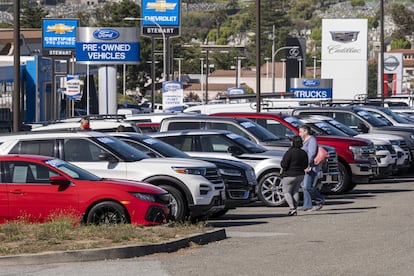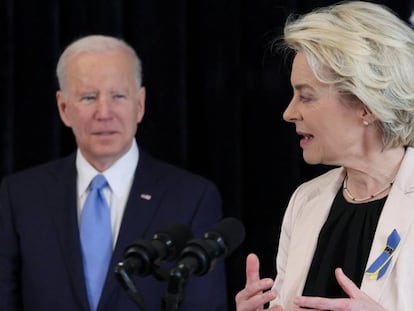California to end sales of gasoline-only cars by 2035
The state has become the first in the US to aim for 100% zero-emission vehicles, a move that is expected to cut greenhouse gases by 50%


California made history on Thursday by becoming the first US state to limit the sale of gasoline cars. The measure, which will take effect in 2035, aims to drastically cut carbon dioxide emissions, by boosting the sale of hybrid and electric cars. The initiative is set to transform the auto industry in California, which is the largest market for car manufacturers – 29 million vehicles are registered in the state, of which 16 million are cars.
The proposal was approved on Thursday by the California Air Resources Board (CARB), the agency in charge of combating air pollution. Vehicles are the main cause of greenhouse gases in the United States, representing 28% of the country’s carbon footprint. By 2026, 35% of all cars for sale in California must be zero-emission vehicles. This figure will rise to 68% in 2030 and 100% in 2035. California estimates that by 2040, the state will have cut greenhouse gases by 50% and smog emissions by 25%. Another 17 states may follow California’s example in the coming years.
But according to experts, it may be difficult for the state to meet its ambitious goals, as the sale of electric vehicles represents only 4.4% of the market in the United States, according to the Alliance for Automotive Innovation. This, however, is the highest number ever recorded and double what was recorded in 2020. The trend is on the rise given the rising cost of gasoline, which has skyrocketed due to the war in Ukraine and inflationary pressure. California leads the US in electric car sales, with these models representing 13% of new car sales. It is followed by Washington D.C. (10.9%), the State of Washington and Hawaii (7.7%), Oregon (7.6%) and Colorado (6.2%).
The cost of an electric car is the main obstacle for buyers. These vehicles cost, on average, about $66,000, while gasoline models can be purchased for an average of $45,000. California’s state officials believe the price of an electric car will drop over the next eight years until it is near on-par with gasoline models.
“California now has a groundbreaking, world-leading plan to achieve 100% zero-emission vehicle sales by 2035,” said the state’s governor, Gavin Newsom, on Thursday. “It’s ambitious, it’s innovative, it’s the action we must take if we’re serious about leaving the planet better off for future generations.”
The Democratic governor presented the proposal through an executive order in September 2020. The politician then redoubled his commitment to cutting greenhouse emissions in California. Seven of the 10 cities with the worst smog problems in the United States are located in California, which has a population of 40 million. “We can solve this climate crisis if we focus on the big, bold steps necessary to cut pollution,” Newsom said in a statement. “This plan’s yearly targets – 35% zero-emission vehicle sales by 2026, 68% by 2030, and 100% by 2035 – provide our roadmap to reducing dangerous carbon emissions and moving away from fossil fuels. That’s 915 million oil barrels’ worth of emissions that won’t pollute our communities.”
Under the measure approved by CARB, manufacturers will be able to continue to sell hybrid models that combine fuel with electricity. These vehicles, however, must have a battery that allows them to travel 80 kilometers (50 miles) before switching to gasoline combustion. California will be able to penalize manufacturers with fines of up to $20,000 for each car that falls short of the objectives set from 2026. Authorities will also have to spend around $2.6 million in the next years on building charging ports across the state. Some organizations, however, have expressed concern that the state’s electric grid is not prepared for such sweeping changes.
Major automakers say there are up for the challenge. “We’re committed to building a zero-emissions transportation future,” Bob Holycross, Chief Sustainability Officer at Ford, said in a statement, which reported that the company will invest $50 billion by 2026 in electric vehicles and batteries. “The CARB Advanced Clean Cars II rule is a landmark standard that will define clean transportation and set an example for the United States,” added Holycross.
Toyota, which unseated GM for the first time last year to become the number one car seller in the US, said it “acknowledged CARB’s leadership in climate policies and its authority to set vehicle emissions standards.” And GM announced in January that it will spend $35 billion over the next three years on autonomous and electric vehicles.
In August 2021, US President Joe Biden issued an executive order that set a new target of electric vehicles representing half of new vehicles sold in 2030. “The question is whether we’ll lead or fall behind in the race for the future,” said Biden when announcing the measure, which was also intended as a show of force against China, a country that produces 70% of the batteries used by electric cars globally. Biden’s initiative aimed to set a roadmap for a cleaner future, but did not set fines or penalties if the target was not reached.
In August 2022, however, the US government passed the Inflation Reduction Act, which earmarks $369 million for clean energy and climate change mitigation initiatives. The Biden administration hopes the measure will cut greenhouse gas emissions by 40% by 2030. The transition to the electric car is key to this goal. And California has taken the first step.
Tu suscripción se está usando en otro dispositivo
¿Quieres añadir otro usuario a tu suscripción?
Si continúas leyendo en este dispositivo, no se podrá leer en el otro.
FlechaTu suscripción se está usando en otro dispositivo y solo puedes acceder a EL PAÍS desde un dispositivo a la vez.
Si quieres compartir tu cuenta, cambia tu suscripción a la modalidad Premium, así podrás añadir otro usuario. Cada uno accederá con su propia cuenta de email, lo que os permitirá personalizar vuestra experiencia en EL PAÍS.
¿Tienes una suscripción de empresa? Accede aquí para contratar más cuentas.
En el caso de no saber quién está usando tu cuenta, te recomendamos cambiar tu contraseña aquí.
Si decides continuar compartiendo tu cuenta, este mensaje se mostrará en tu dispositivo y en el de la otra persona que está usando tu cuenta de forma indefinida, afectando a tu experiencia de lectura. Puedes consultar aquí los términos y condiciones de la suscripción digital.
More information
Archived In
Últimas noticias
Iranian women are also defying the taboo of riding motorcycles (and without a license)
David Bowie, the galactic thinker who encouraged us to break new ground
John Berger and the loss of rural culture
From police officer to bloodthirsty kidnapper: Terror in Mexico during the years of ‘The Ear Chopper’
Most viewed
- David King, chemist: ‘There are scientists studying how to cool the planet; nobody should stop these experiments from happening’
- Reinhard Genzel, Nobel laureate in physics: ‘One-minute videos will never give you the truth’
- Oona Chaplin: ‘I told James Cameron that I was living in a treehouse and starting a permaculture project with a friend’
- Mexico completes its trade shift with the entry into force of tariffs on China and countries without trade agreements
- Sinaloa Cartel war is taking its toll on Los Chapitos









































